Setting Up Active Analytics Framework for Automatic Enrollment Due to HCM Status and Job Changes
Note: As illustrated in the screen shots of this topic, PeopleSoft ELM delivers examples of Active Analytics Framework (AAF) setup for the purpose of automatic enrollment due to HCM status and job changes. You can use this sample data as a model when defining the AAF setup for your own system.
|
Page Name |
Definition Name |
Usage |
|---|---|---|
|
EOCF_EVTYP_DEFN |
Define trigger types. |
|
|
EOCF_CONTEXT_DEFN |
Define context objects. |
|
|
EOCF_ACTN_TYPE_REG |
Register action types. |
|
|
EOCF_EVENT_DEFN |
Define trigger points. |
|
|
EOCF_IMPL_DEFN |
Define an implementation. |
|
|
EOCF_SUBJ_HIER |
Define subject areas. |
|
|
EOCF_TERM_DEFN |
Define and manage terms. |
|
|
EOCF_TERM_SUBAREA |
Define subject area details for a term. |
|
|
EOCF_TERM_INACTION |
Define policy options for a term. |
|
|
EOCF_RULE_DEFN |
Configure a policy. |
|
|
EOCF_RULE_PHRASE |
Edit a condition defined for a policy. |
|
|
EOCF_RULE_ACTION |
Edit an action defined for a policy. |
|
|
LM_AAF_LEARNING |
Add learning to a policy action. |
|
|
LM_AAF_PYMTS |
Define payment details for learning associated with a policy action. |
Use the Register Trigger Type page (EOCF_EVTYP_DEFN) to define trigger types.
Navigation:
This example illustrates the fields and controls on the Register Trigger Type page.
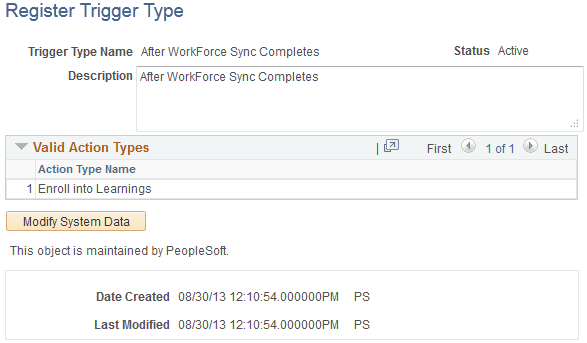
Use this page to define trigger types that are used to group similar triggers together.
For more information on this page, see Registering Trigger Types and Trigger Points.
Use the Manage Context Object - Definition page (EOCF_CONTEXT_DEFN) to define context objects.
Navigation:
This example illustrates the fields and controls on the Manage Context Object - Definition page.
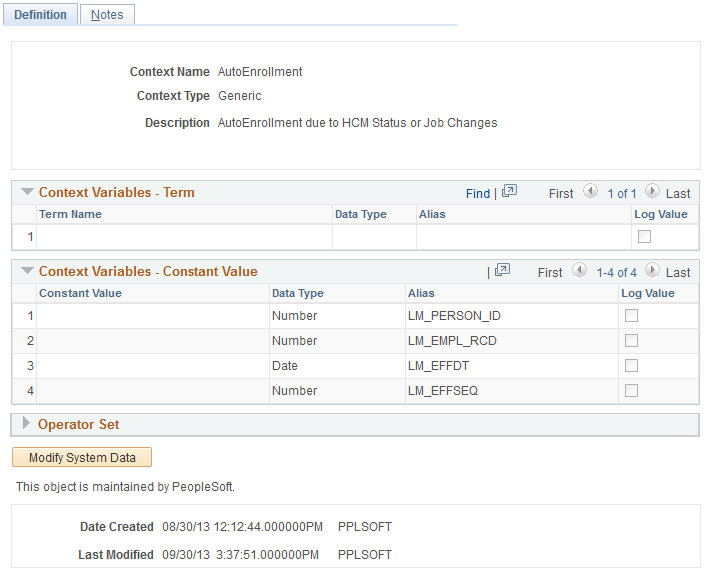
Use this page to specify the context variables that the system uses for term resolution. You associate the context defined here with trigger points and terms.
Note: In this example, the value of the Context Type field is Generic because it is used outside of the component.
For more information on this page, see Configuring Contexts.
Use the Register Action Type page (EOCF_ACTN_TYPE_REG) to register action types.
Navigation:
This example illustrates the fields and controls on the Register Action Type page.
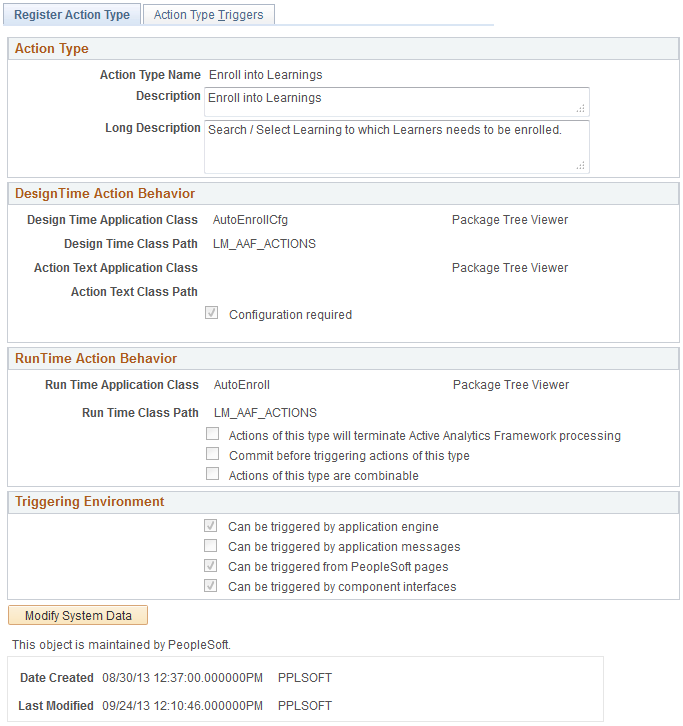
Use this page to define the action type that determines the behavior of the policy.
Design Time Action Behavior
This example uses the AutoEnrollCfg Design Time Application Class , which drives policy action behavior during policy configuration. The AutoEnrollCfg application class is what enables you to access the Learnings page when you click the Configure button on the Edit Actions Page.
Run Time Action Behavior
This example uses the AutoEnroll Run Time Application Class, which includes the logic that drives policy behavior when the policy is executed.
For more information on this page, see Registering Action Types and Action Type Bundles.
Use the Register Trigger Point page (EOCF_EVENT_DEFN) to define trigger points.
Navigation:
This example illustrates the fields and controls on the Register Trigger Point page.
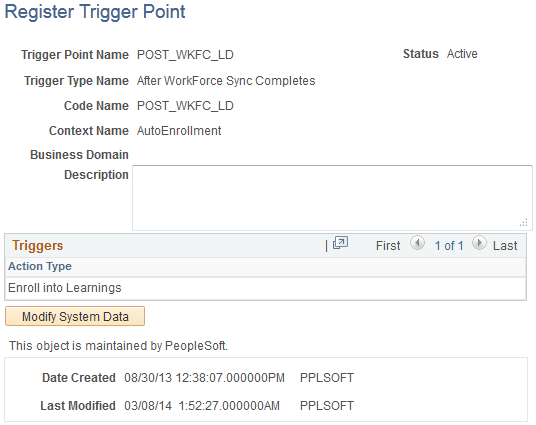
This example shows the POST_WKFC_LD trigger point. At run time, the system evaluates all policies associated with the POST_WKFC_LD trigger point using the batch process LM_AENRL_AAF. The system initiates this process when the Process Asynchronous Data (LM_LD_ASYC) batch process completes if the Allow Auto Enrollment check box is selected on the Install Defaults - Enrollment page.
Notice that the trigger type and the context object are mapped to the trigger point.
Use the Define Implementation page (EOCF_IMPL_DEFN) to define an implementation.
Navigation:
This example illustrates the fields and controls on the Define Implementation page.
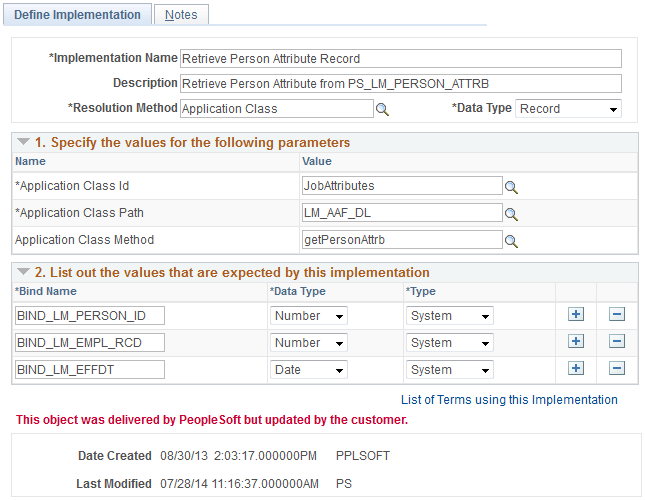
Use this page to define implementations, which specify the logic that the system uses during term resolution. This example illustrates an implementation defined for retrieving terms associated with person attribute data, such as JobCode_ID.
Use the Define Subject Areas page (EOCF_SUBJ_HIER) to define subject area.
Navigation:
This example illustrates the fields and controls on the Define Subject Areas page.
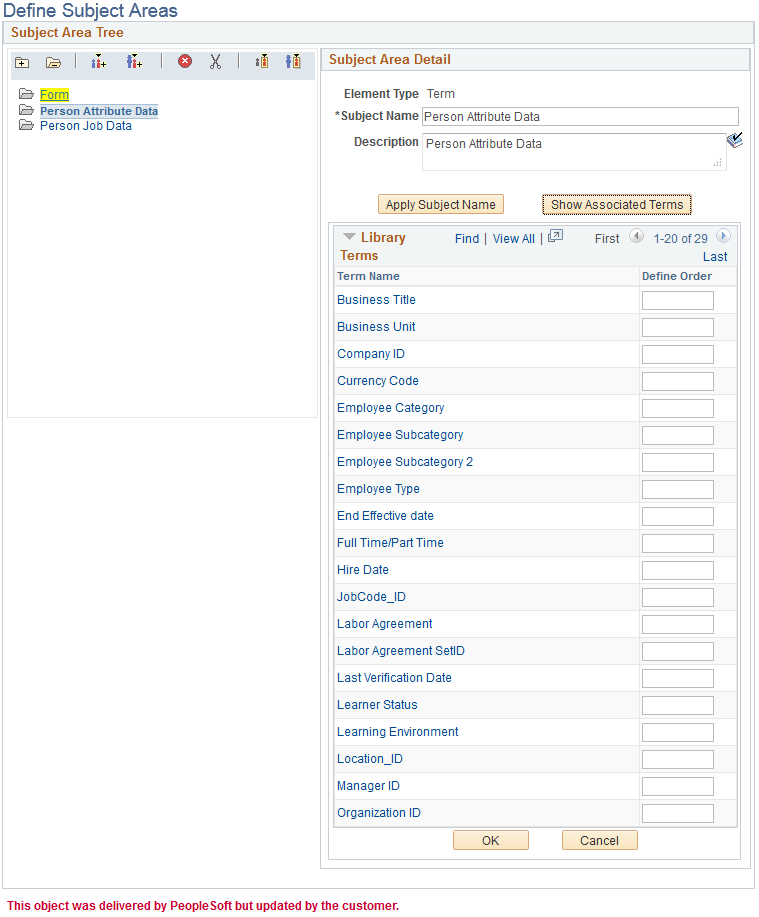
Before you define terms, you must create subject areas in which you can group related terms. When you define a term, you associate it to a subject area.
Field or Control |
Description |
|---|---|
Show Associated Terms |
Click to view a list of terms that are currently associated to the subject area. |
For more information on this page, see Defining Subject Areas.
Use the Manage Terms - Term Definition page (EOCF_TERM_DEFN) to define and manage terms.
Navigation:
This example illustrates the fields and controls on the Manage Terms - Term Definition page.
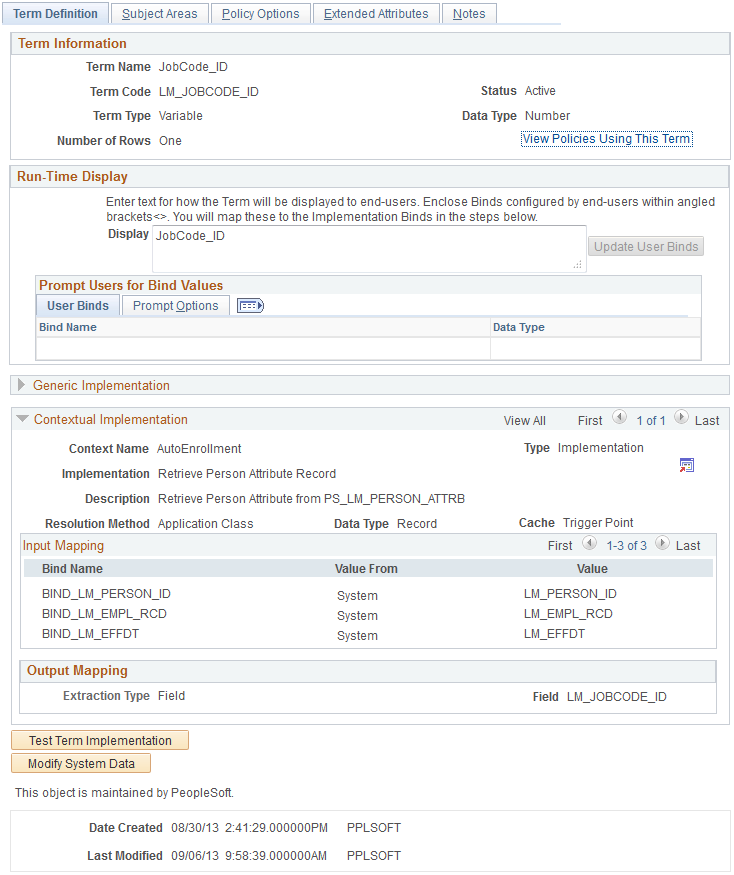
Use this page to define terms, which are the building blocks used to define policy conditions. You must register a term in the Active Analytics Framework before you can use it. The system evaluates imported employee data based on the terms used in policy conditions. Terms are resolved as either true or false.
Field or Control |
Description |
|---|---|
Test Term Implementation |
Click to access the Test Term Implementation page where you can enter sample values to test the term results. |
For more information on this page, see Managing Terms.
Use the Manage Terms - Subject Areas page (EOCF_TERM_SUBAREA) to define subject area details for a term.
Navigation:
This example illustrates the fields and controls on the Manage Terms - Subject Areas page.

Use this page to associate a term with relevant subject areas.
For more information on this page, see Managing Terms.
Use the Manage Terms - Policy Options page (EOCF_TERM_INACTION) to define policy options for a term.
Navigation:
This example illustrates the fields and controls on the Manage Terms - Policy Options page.

Use this page to determine how term values will be selectable during the configuration of policies that use the term. In this example, the term has a Prompt Type of Prompt, so when configuring a policy using this term, users can select a value using a prompt table. Other values for the Prompt Type field include Custom, Dropdown, and Translate.
For more information on this page, see Managing Terms.
Use the Build a Policy page (EOCF_RULE_DEFN) to configure a policy.
Navigation:
This example illustrates the fields and controls on the Build a Policy page.
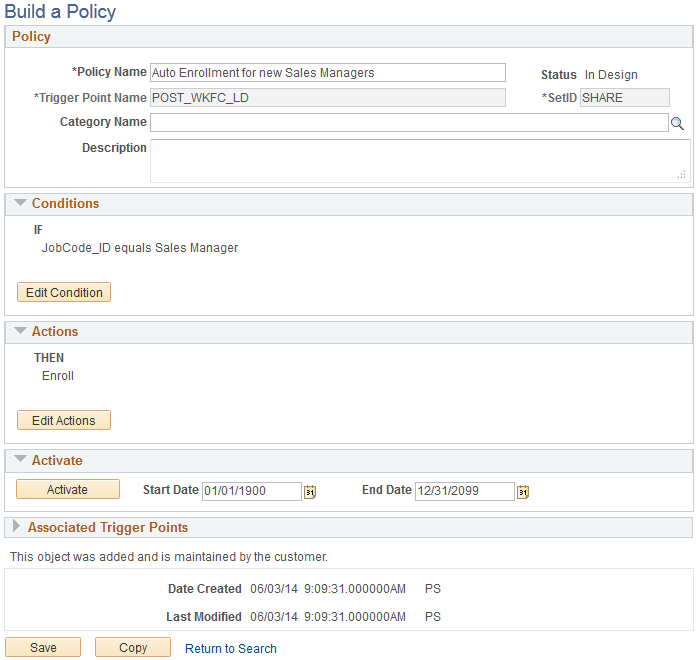
You can use this page to build a new policy or to edit an existing policy.
In this example, the policy is associated with the POST_WKFC_LD trigger point. At run time, the system evaluates all policies associated with the POST_WKFC_LD trigger point using the batch process LM_AENRL_AAF. The system initiates this process when the Process Asynchronous Data (LM_LD_ASYC) batch process completes if the Allow Auto Enrollment check box is selected on the Install Defaults - Enrollment page.
By changing policy conditions and actions, you can reconfigure application components, thereby enabling a business process change without having to modify application code, or requesting help from IT personnel.
Note: All delivered policies have a Status of In Design and must be activated before they can be used.
Use the Edit Condition page (EOCF_RULE_PHRASE) to edit conditions defined for a policy.
Note: If you are building a new policy, this page is labeled Add Condition.
Navigation:
Click the Edit Condition or Add Condition button on the Build a Policy page.
This example illustrates the fields and controls on the Edit Condition page.
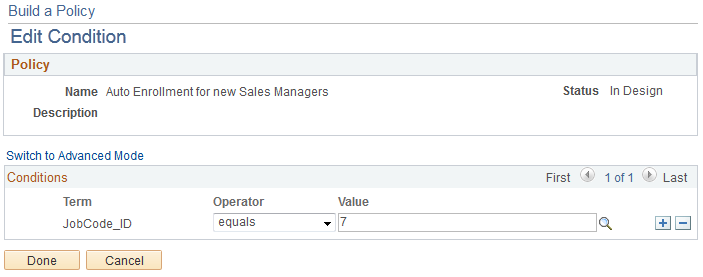
There are two modes available for specifying conditions:
Basic.
This is the default mode; the default logical operator is AND.
Advanced.
You can group condition rows using parentheses, specify logical operators (AND, OR), and specify terms as values in the right-hand side.
To add a condition row:
Select a term. Configure the term if it is linked.
Select an operator.
Enter or select one or more values on the right-hand side.
For more information on this page, see Building Policies.
Use the Edit Actions page (EOCF_RULE_ACTION) to edit actions defined for a policy.
Note: If you are building a new policy, this page is labeled Add Actions.
Navigation:
Click the Edit Action or Add Action button on the Build a Policy page.
This example illustrates the fields and controls on the Edit Actions page.
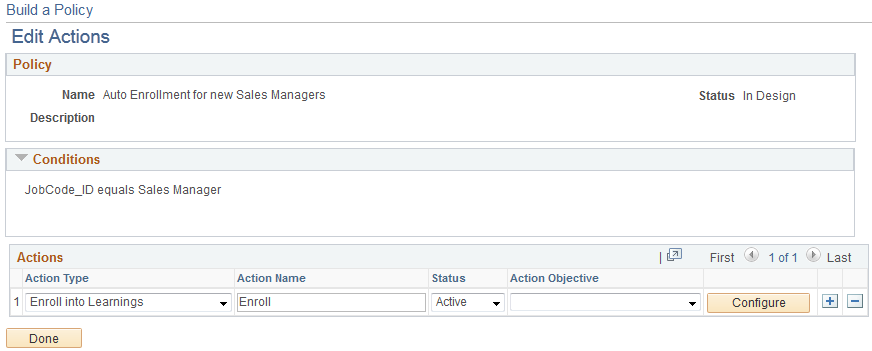
For actions with the Enroll into Learnings action type, you can click the Configure button to access the Learnings page where you can add learning items for the policy action.
Use the Learnings page (LM_AAF_LEARNING) to add learning to a policy action.
Navigation:
Click the Configure button on the Edit Actions page.
This example illustrates the fields and controls on the Learnings page.
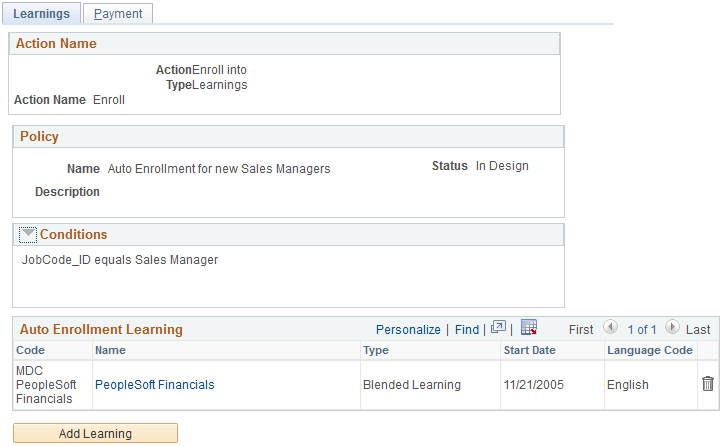
This page is developed specifically for ELM. It enables you to add learning items to the policy action.
Field or Control |
Description |
|---|---|
Add Learning |
Click to access the Find Learning page where you can select learning items to add to the policy action. |
Use the Payment page (LM_AAF_PYMTS) to define payment details for learning associated with a policy action.
Navigation:
Click the Payment tab from the Learnings page.
This example illustrates the fields and controls on the Payment page.
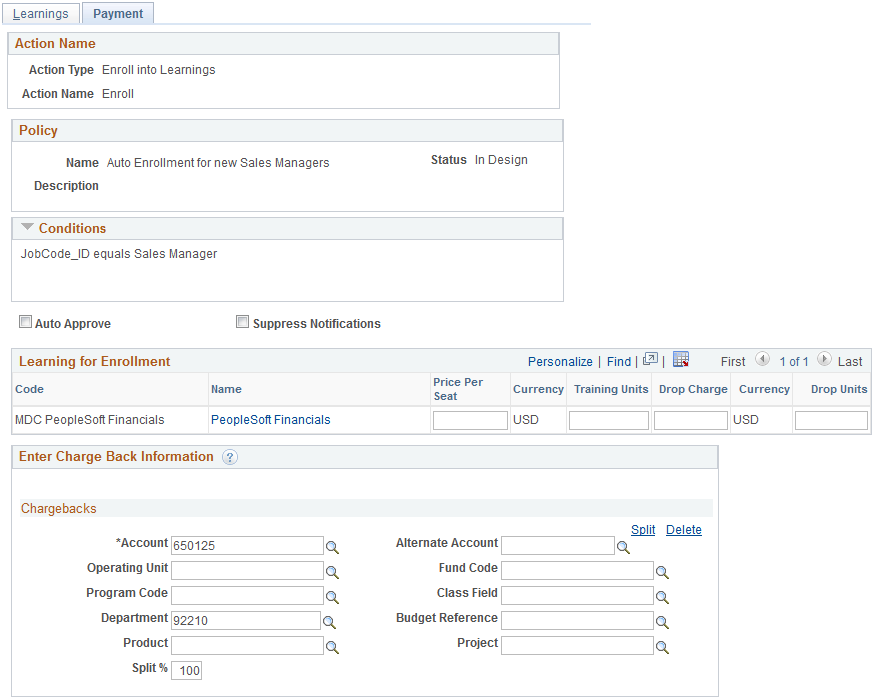
This page is developed specifically for ELM. It enables you to enter payment details such as class fees and chargeback information for the learning items associated with the policy action.
The fields and controls of this page are identical to those on the Enroll Learners - Payment Details Page.